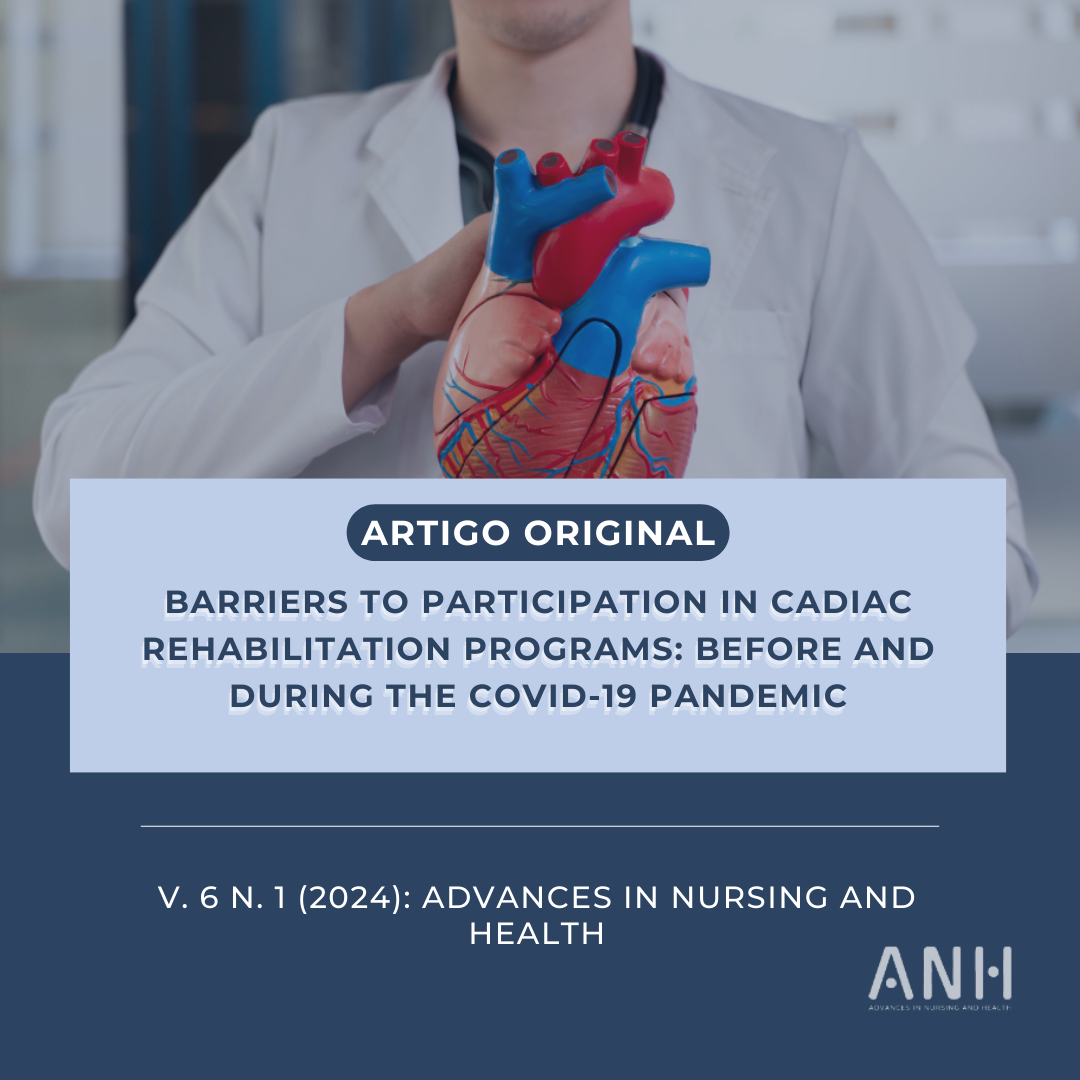Barriers to participation in cadiac rehabilitation programs: before and during the Covid-19 pandemic
Barriers to participation in cadiac rehabilitation programs
DOI:
https://doi.org/10.5433/anh.2024v6.id47913Keywords:
Barriers to Access of Health Services, Cardiac Rehabilitation, COVID-19, Health Services Accessibility, Longitudinal Studies, Telephone InterviewAbstract
Objevtive: Comparing perceived barriers to participation in cardiac rehabilitation programs before and during the coronavirus disease 2019 pandemic. Method: Observational, analytical, and longitudinal study conducted with 23 participants enrolled in a cardiac rehabilitation program, phases 2 and 3. Before the pandemic, participants responded to the 21 items of the Cardiac Rehabilitation Barriers Scale, scored from 21 to 105. with higher values indicating greater perception of barriers During the pandemic period, 18 (78%) participants responded again to the instrument. The paired t-test was used to compare the mean total score and the items of the instrument at the two time points. Results: The results show a decrease in the perception of barriers to participation in the Cardiac Rehabilitation Program from the first to the second interview. When comparing the mean values, statistically significant differences were found for the total score of the Barrier Scale (p <0.001), for the total mean of the items (p <0.001), and for the means of 17 of the 21 items. Conclusion: The significantly lower scores in the second interview indicate that participants perceived fewer barriers to attending cardiac rehabilitation during the pandemic period than before when the service was operating regularly.
Downloads
References
BRASIL. Constituição da República Federativa do Brasil. Brasília (DF); 1988.
Sanders LM, Shaw JS, Guez G, Baur C, Rudd R. Health Literacy and Child Health Promotion: Implications for Research, Clinical Care, and Public Policy. Pediatrics. 2009;124(Supplement 3): S306-S314. https://doi.org/10.1542/peds.2009-1162G. DOI: https://doi.org/10.1542/peds.2009-1162G
Brasil. Ministério da Saúde. Departamento de Informática do SUS. Sistema de informações sobre morbidade hospitalar do SUS. http://tabnet.datasus.gov.br/cgi/menu_tabnet_php.htm# [Accessed 24th March 2022].
Marzolini S. Including Patients With Stroke in Cardiac Rehabilitation. Journal of Cardiopulmonary Rehabilitation and Prevention. 2020;40(5): 294-301. https://doi.org/10.1097/HCR.0000000000000540. DOI: https://doi.org/10.1097/HCR.0000000000000540
Besnier F, Gayda M, Nigam A, Juneau M, Bherer L. Cardiac Rehabilitation During Quarantine in COVID-19 Pandemic: Challenges for Center-Based Programs. Archives of Physical Medicine and Rehabilitation. 2020; https://doi.org/10.1016/j.apmr.2020.06.004. DOI: https://doi.org/10.1016/j.apmr.2020.06.004
Driggin E, Madhavan M V., Bikdeli B, Chuich T, Laracy J, Biondi-Zoccai G, et al. Cardiovascular Considerations for Patients, Health Care Workers, and Health Systems During the COVID-19 Pandemic. Journal of the American College of Cardiology. 2020. p. 2352-2371. https://doi.org/10.1016/j.jacc.2020.03.031. DOI: https://doi.org/10.1016/j.jacc.2020.03.031
Vigorito C, Faggiano P, Mureddu GF. COVID-19 pandemic: what consequences for cardiac rehabilitation? Monaldi Archives for Chest Disease. 2020;90(1). https://doi.org/10.4081/monaldi.2020.1315. DOI: https://doi.org/10.4081/monaldi.2020.1315
Forhan M, Zagorski BM, Marzonlini S, Oh P, Alter DA. Predicting Exercise Adherence for Patients with Obesity and Diabetes Referred to a Cardiac Rehabilitation and Secondary Prevention Program. Canadian Journal of Diabetes. 2013;37(3): 189-194. https://doi.org/10.1016/j.jcjd.2013.03.370. DOI: https://doi.org/10.1016/j.jcjd.2013.03.370
Borges GLB, Cruz MMA da, Ricci-Vitor AL, Silva PF da, Grace SL, Vanderlei LCM. Publicly versus privately funded cardiac rehabilitation: access and adherence barriers. A cross-sectional study. Sao Paulo Medical Journal. 2022;140(1): 108-114. https://doi.org/10.1590/1516-3180.2020.0782.r1.31052021. DOI: https://doi.org/10.1590/1516-3180.2020.0782.r1.31052021
Sérvio TC, Britto RR, de Melo Ghisi GL, da Silva LP, Silva LDN, Lima MMO, et al. Barriers to cardiac rehabilitation delivery in a low-resource setting from the perspective of healthcare administrators, rehabilitation providers, and cardiac patients. BMC Health Services Research. 2019;19(1): 615. https://doi.org/10.1186/s12913-019-4463-9. DOI: https://doi.org/10.1186/s12913-019-4463-9
Cunha CM, da Cunha DCPT, Manzato R de O, Nepomuceno E, da Silva D, Dantas RAS. Validation of the Brazilian Version of the Patient Activation Measure 13. Journal of Nursing Measurement. 2019;27(1): 97-113. https://doi.org/10.1891/1061-3749.27.1.97. DOI: https://doi.org/10.1891/1061-3749.27.1.97
Ghisi GL de M, Santos RZ dos, Schveitzer V, Barros AL, Recchia TL, Oh P, et al. Desenvolvimento e validação da versão em português da Escala de Barreiras para Reabilitação Cardíaca. Arquivos Brasileiros de Cardiologia. 2012;98(4): 344-352. https://doi.org/10.1590/S0066-782X2012005000025. DOI: https://doi.org/10.1590/S0066-782X2012005000025
Jean Mundahl Engels PD. Imputation of missing longitudinal data: a comparison of methods. Journal of Clinical Epidemiology. 2003;56(10): 968-976. https://doi.org/10.1016/S0895-4356(03)00170-7. DOI: https://doi.org/10.1016/S0895-4356(03)00170-7
Malta DC, Gomes CS, Szwarcwald CL, Barros MB de A, Silva AG da, Prates EJS, et al. Distanciamento social, sentimento de tristeza e estilos de vida da população brasileira durante a pandemia de Covid-19. Saúde em Debate. 2020;44(spe4): 177-190. https://doi.org/10.1590/0103-11042020e411. DOI: https://doi.org/10.1590/0103-11042020e411
Sepúlveda-Loyola W, Rodríguez-Sánchez I, Pérez-Rodríguez P, Ganz F, Torralba R, Oliveira D V., et al. Impact of Social Isolation Due to COVID-19 on Health in Older People: Mental and Physical Effects and Recommendations. The journal of nutrition, health & aging. 2020;24(9): 938-947. https://doi.org/10.1007/s12603-020-1500-7. DOI: https://doi.org/10.1007/s12603-020-1500-7
Botero JP, Farah BQ, Correia M de A, Lofrano-Prado MC, Cucato GG, Shumate G, et al. Impact of the COVID-19 pandemic stay at home order and social isolation on physical activity levels and sedentary behavior in Brazilian adults. Einstein (São Paulo). 2021;19. https://doi.org/10.31744/einstein_journal/2021AE6156. DOI: https://doi.org/10.31744/einstein_journal/2021AE6156
Silva DRP da, Werneck AO, Malta DC, Souza Júnior PRB de, Azevedo LO, Barros MB de A, et al. Changes in the prevalence of physical inactivity and sedentary behavior during COVID-19 pandemic: a survey with 39,693 Brazilian adults. Cadernos de Saúde Pública. 2021;37(3). https://doi.org/10.1590/0102-311x00221920. DOI: https://doi.org/10.1590/0102-311x00221920
Britto RR, Supervia M, Turk-Adawi K, Chaves GS da S, Pesah E, Lopez-Jimenez F, et al. Cardiac rehabilitation availability and delivery in Brazil: a comparison to other upper middle-income countries. Brazilian Journal of Physical Therapy. 2020;24(2): 167-176. https://doi.org/10.1016/j.bjpt.2019.02.011. DOI: https://doi.org/10.1016/j.bjpt.2019.02.011
Hennis AJM, Coates A, del Pino S, Ghidinelli M, Gomez Ponce de Leon R, Bolastig E, et al. COVID-19 and inequities in the Americas: lessons learned and implications for essential health services. Revista Panamericana de Salud Pública. 2021;45: 1. https://doi.org/10.26633/RPSP.2021.130. DOI: https://doi.org/10.26633/RPSP.2021.130
Carvalho T de, Milani M, Ferraz AS, Silveira AD da, Herdy AH, Hossri CAC, et al. Diretriz Brasileira de Reabilitação Cardiovascular - 2020. Arquivos Brasileiros de Cardiologia. 2020;114(5): 943-987. https://doi.org/10.36660/abc.20200407. DOI: https://doi.org/10.36660/abc.20200407
Souza TS de, Aleluia ÍRS, Pinto EB, Pinto Junior EP, Pedreira RBS, Fraga-Maia H, et al. Organização e oferta da assistência fisioterapêutica em resposta à pandemia da COVID-19 no Brasil. Ciência & Saúde Coletiva. 2022;27(6): 2133-2142. https://doi.org/10.1590/1413-81232022276.00752022. DOI: https://doi.org/10.1590/1413-81232022276.00752022
Buttery AK. Cardiac Rehabilitation for Frail Older People. In: 2020. p. 131-147. https://doi.org/10.1007/978-3-030-33330-0_13. DOI: https://doi.org/10.1007/978-3-030-33330-0_13
Quindry JC, Franklin BA, Chapman M, Humphrey R, Mathis S. Benefits and Risks of High-Intensity Interval Training in Patients With Coronary Artery Disease. The American Journal of Cardiology. 2019;123(8): 1370-1377. https://doi.org/10.1016/j.amjcard.2019.01.008. DOI: https://doi.org/10.1016/j.amjcard.2019.01.008
Rangel-S ML, Lamego G, Paim M, Brotas A, Lopes A. SUS na mídia em contexto de pandemia. Saúde em Debate. 2022;46(134): 599-612. https://doi.org/10.1590/0103-1104202213401. DOI: https://doi.org/10.1590/0103-1104202213401
Schmied C. 'Cardiac rehabilitation works': but it should be tailored individually, started early, and followed for a lifetime. European Heart Journal. 2019. p. 686-688. https://doi.org/10.1093/eurheartj/ehy618. DOI: https://doi.org/10.1093/eurheartj/ehy618

Published
How to Cite
Issue
Section
License
Copyright (c) 2024 Pedro Paulo Fernandes de Aguiar Tonetto, Arthur Marco Peres Ribeiro, Carina Aparecida Marosti Dessotte, Rosana Aparecida Spadoti Dantas (Autor)

This work is licensed under a Creative Commons Attribution 4.0 International License.
All or the content of the newspaper is licensed under a Creative Commons Attribution License, of the CC-BY attribution type.
Authors retain the copyright, and authors are asked to indicate first publication in this journal in the event of republication. Articles published in Advances in Nursing and Health are licensed under the Creative Commons Attribution 4.0 International License, which ensures Open Access. This license allows any user to read, download, copy, and share the content, as long as it is properly cited. It also permits the reuse of the material, including its distribution, adaptation, and creation of derivative works in any format or medium, provided appropriate credit is given, a link to the license is provided, and any changes made are indicated. In addition, the license allows commercial use of the content.


















